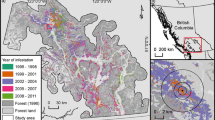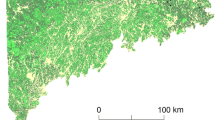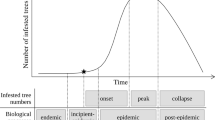Abstract
The relationship between outbreak characteristics of the spruce budworm and the combination of climate, forest composition, and spatial location was examined in eastern Canada by the method of constrained ordination. Approximately 54% of the spatial variability in outbreak pattern, as described by a matrix of four outbreak characteristics, was explained by the spatial pattern of the climate (a matrix of six variables), forest composition (a matrix of seven variables), and spatial location (a matrix of two variables). The relationships between outbreak variables and climate variables were highlighted, and future outbreak characteristics of the spruce budworm were projected using simulations of a global circulation model for the period 2081–2100 where CO2 concentrations reach a maximum of approximately 550 ppm. Future outbreaks are predicted to be an average of approximately 6 years longer with an average of 15% greater defoliation. The methodology is described and the potential effects of climate change on landscape-scale outbreaks of the insect are discussed.
Similar content being viewed by others
References
Apps MJ, Price DT (1996) Introduction. In: Apps MJ, Price DT (eds) Forest ecosystems, forest management and the global carbon cycle. Springer, Heidelberg, Germany, pp 19–24
Belyea RM (1952) Death and deterioration of balsam fir weakened by spruce budworm defoliation in Ontario. Part II. An assessment of the role of associated insect species in the death of severely weakened trees. J For 50:729–738
Besag J, Clifford P (1989) Generalized Monte Carlo significance tests. Biometrika 76:633–642
Blais JR (1968) Regional variation in susceptibility of eastern North American forests to budworm attack based on history of outbreaks. For Chron 44:17–23
Blais JR (1983) Trends in the frequency, extent, and severity of spruce budworm outbreaks in Eastern Canada. Can J For Res 13:539–547
Borcard D, Legendre P, Drapeau P (1992) Partialling out the spatial component of ecological variation. Ecology 73:1045–1055
Boulanger Y, Arsenault D (2004) Spruce budworm outbreaks in Eastern Quebec over the last 450 years. Can J For Res 34:1035–1043
Brasseur GP, Prinn RG, Pszenny AP (2003) Atmospheric chemistry in a changing world: an integration and synthesis of a decade of tropospheric chemistry research. Springer, New York, USA, p 300
Candau J-N, Fleming RA, Hopkin A (1998) Spatiotemporal patterns of large-scale defoliation caused by the spruce budworm in Ontario since 1941. Can J For Res 28:1733–1741
Cappuccino N, Lavertu D, Bergeron Y, Régnière J (1998) Spruce budworm impact, abundance and parasitism rate in a patchy landscape. Oecologia 114:236–242
Cofer WRI, Winstead EL, Stocks BJ, Cahoon DR, Goldammer JG, Levine JS (1996) Composition of smoke from North American boreal forest fires. In: Goldammer JG, Furyaev VV (eds) Fire in ecosystems of boreal Eurasia. Kluwer, Dordrecht, pp 465–475
Davis AJ, Jenkinson LS, Lawton JH, Shorrocks B, Wood S (1998) Making mistakes when predicting shifts in species range in response to global warming. Nature 391:783–786
Deslauriers A, Morin H, Urbinati C, Carrer M (2003) Daily weather responses of balsam fir (Abies balsamea (L.) Mill.) stem radius increment from dendrometer analysis in the boreal forests of Québec (Canada). Trees 17:477–484
Dunne T, Leopold LB (1978) Water in environmental planning. Freeman, San Francisco, p 818
Elliott KR (1960) A history of recent infestations of the spruce budworm in North-Western Ontario, and an estimate of resultant timber losses. For Chron 36:61–82
Elliott NC, Simmons GA, Draper RJ (1986) Adult emergence and activity patterns of parasites of early instar jack pine budworm (Lepidoptera: Tortricidae). Environ Entomol 15:409–416
ESRI (2006) ‘ARC-Info ver. 9.2.’ Redlands, CA
Eyre FH, Ostrom CE (1965) Silvics of forest trees of the United States. Agriculture handbook. No. 271, United States Department of Agriculture, Forest Service
Fleming RA (1996) A mechanistic perspective of possible influences of climate change on defoliating insects in North America’s boreal forest. Silva Fenn 30:281–294
Fleming RA (2000) Climate change and insect disturbance regimes in Canada’s boreal forests. World Resour Rev 12:520–554
Fleming RA, Shoemaker CA, Stedinger JR (1984) An assessment of the impact of large scale spraying operations on the regional dynamics of spruce budworm (Lepidoptera: Tortricidae) populations. Can Entomol 116:633–644
Fleming RA, Candau J-N, McAlpine RS (2002) Landscape-scale analysis of interactions between insect defoliation and forest fire in Central Canada. Clim Change 55:251–272
Gray DR (1994) Gypsy moth development – a model of phenological events. PhD Dissertation. Virginia Polytechnic Institute and State University, Blacksburg, VA
Gray DR, MacKinnon WE (2007) Historical spruce budworm defoliation records adjusted for insecticide spraying in New Brunswick from 1965–1992. J Acadian Entomol Soc 3:1–6
Gray SL, Power K (1997) Canada’s forest inventory 1991: the 1994 version – technical supplement. Information Report. BC-X-363, Natural Resouces Canada, Canadian Forest Service – Pacific Forestry Centre
Gray DR, Régnière J, Boulet B (1999) Analysis and use of historical patterns of spruce budworm defoliation to forecast outbreak patterns in Quebec. For Ecol Manag 127:217–231
Greenbank DO (1956) The role of climate and dispersal in the inititiation of outbreaks of the spruce budworm in New Brunswick. 1. The role of climate. Can J Zool 34:453–476
Greenbank DO (1963) Host species and the spruce budworm. Mem Entomol Soc Can 31:219–223
Greenbank DO, Schaefer GW, Rainey RC (1980) Spruce budworm (Lepidoptera: Tortricidae) moth flight and dispersal: new understanding from canopy observations, radar, and aircraft. Mem Entomol Soc Can 110:1–49
Hall JP, Moody BH (1994) Forest depletions caused by insects and diseases in Canada 1982–1987. Canadian Forest Service Information Report. ST-X-8
Hardy Y, Lafond A, Hamel L (1983) The epidemiology of the current spruce budworm outbreak in Quebec. For Sci 29:715–725
Hardy Y, Mainville M, Schmitt DM (1986) An atlas of spruce budworm defoliation in eastern North America, 1938–1980. Miscellaneous Publication 1449, United States Department of Agriculture, Forest Service, Washington, DC
Harlow WM, Harrar ES, White FM (1979) Textbook of dendrology. McGraw-Hill, New York
Harvey GT (1983) Environmental and genetic effects on mean egg weight in spruce budworm (Lepidoptera: Tortricidae). Can Entomol 115:1109–1117
Huber JT, Eveleigh ES, Pollock S, McCarthy P (1996) The chalcidoid parasitoids and hyperparasitoids (Hymenoptera: Chalcidoidea) of Choristoneura species (Lepidoptera: Tortricidae) in America North of Mexico. Can Entomol 128:1167–1220
Ives WGH (1974) Weather and outbreaks of the spruce budworm, Choristoneura fumiferana (Lepidoptera: Tortricidae). Information Report. NOR-X-118, Department of the Environment, Canadian Forestry Service – Northern Forest Research Centre
Kemp WP (1978) The influence of stand factors on parasitism of spruce budworm eggs by Trichogramma minutum. Environ Model Softw 7:685–688
Kettela EG (1995) Insect control in New Brunswick, 1974–1989. In: Armstrong JA, Ives WGH (eds) Forest insect pests in Canada. Natural Resources Canada – Canadian Forest Service, Ottawa, ON, Canada, pp 655–665
Kurz WA, Apps MJ (1999) A 70-year retrospective analysis of carbon fluxes in the Canadian forest sector. Ecol Appl 9:526–547
Lekas TM, MacDougal RG, MacLean DA, Thompson RG (1990) Seasonal trends and effects of temperature and rainfall on stem electrical capacitance of spruce and fir trees. Can J For Res 20:970–977
Lepš J, Šmilauer P (2003) Multivariate analysis of ecological data using CANOCO. Cambridge University Press, Cambridge, UK, p 269
Lysyk TJ (1990) Relationships between spruce budworm (Lepidoptera: Tortricidae) egg mass density and resultant defoliation of balsam fir and white spruce. Can Entomol 122:253–262
Lysyk TJ, Nealis VG (1988) Temperature requirements for development fo the jack pine budworm (Lepidoptera: Tortricidae) and two of its parasitoids (Hymenoptera). J Econ Entomol 81:1045–1051
MacLean DA, MacKinnon WE (1996) Accuracy of aerial sketch-mapping estimates of spruce budworm defoliation in New Brunswick. Can J For Res 26:2099–2108
MacLean DA, Erdle TA, MacKinnon WE, Porter KB, Beaton KP, Cormier G, Morehouse S, Budd M (2001) The spruce budworm decision support system: forest protection planning to sustain long-term wood supply. Can J For Res 31:1742–1757
Miller CA (1977) The feeding impact of spruce budworm on balsam fir. Can J For Res 7:76–84
Morris RF (1963) Foliage depletion and the spruce budworm. Mem Entomol Soc Can 31:223–227
Murray FW (1967) On the computation of saturation vapor pressure. J Appl Meteorol 6:203–204
Nealis VG (1988) Weather and the ecology of Apanteles fumiferanae Vier. (Hymenoptera: Braconidae). Mem Entomol Soc Can 146:57–70
Nealis VG, Fraser S (1988) Rate of development, reproduction, and mass-rearing of Apanteles fumiferanae Vier. (Hymenoptera: Braconidae) under controlled conditions. Can Entomol 120:197–204
Nealis VG, Régnière J (2004) Insect-host relationships influencing disturbance by the spruce budworm in a boreal mixedwood forest. Can J For Res 34:1870–1882
Nyrop JP, Simmons GA (1986) Temporal and spatial activity patterns of an adult parasitoid, Glypta fumiferanae (Hymenoptera: Ichneumonidae), and their influence on parasitism. Environ Entomol 15:481–487
Pilon JG, Blais JR (1961) Weather and outbreaks of the spruce budworm in the province of Quebec from 1939 to 1956. Can Entomol 63:118–123
Régnière J (1996) Generalized approach to landscape-wide seasonal forecasting with temperature-driven simulation models. Environ Entomol 25:869–881
Régnière J, Bolstad P (1994) Statistical simulation of daily air temperature patterns in eastern North America to forecast seasonal events in insect pest management. Environ Entomol 23:1368–1380
Régnière J, Duval P (1998) Overwintering mortality of spruce budworm, Choristoneura fumiferana (Clem.) (Lepidoptera: Tortricidae), populations under field conditions. Can Entomol 130:13–26
Régnière J, You M (1991) A simulation model of spruce budworm (Lepidoptera: Tortricidae) feeding on balsam fir and white spruce. Ecol Model 54:277–297
Riihimäki J, Kaitaniemi P, Koricheva J (2005) Testing the enemies hypothesis in forest stands: the important role of tree species composition. Oecologia 142:90–97
Roberts EA, Ravlin FW, Fleischer SJ (1993) Spatial data representation for integrated pest management programs. Am Entomol 39:92–107
Royama T (1984) Population dynamics of the spruce budworm. Ecol Monogr 54:429–462
Royama T (1992) Analytical population ecology. Chapman & Hall, London, UK, p 371
Royama T, MacKinnon WE, Kettela EG, Carter NE, Hartling LK (2005) Analysis of spruce budworm outbreak cycles in New Brunswick, Canada, since 1952. Ecology 86:1212–1224
Running SW, Nemani RR, Hungerford RD (1987) Extrapolation of synoptic meteorological data in mountainous terrain and its use for simulating forest evapotranspiration and photosynthesis. Can J For Res 17:472–483
Sanders CJ, Wallace DR, Lucuik GS (1978) Flight activity of female eastern spruce budworm (Lepidoptera: Tortricidae) at constant temperatures in the laboratory. Can Entomol 110:627–632
SAS Institute (1999) SAS/STAT® user’s guide, version 8. SAS, Cary, NC, p 3884
Simmons GA, Leonard DE, Chen CW (1975) Influence of tree species density and composition on parasitism of the spruce budworm, Choristoneura fumiferana. Environ Entomol 4:832–836
Smitley DR, Bauer LS, Hajek AE, Sapio FJ, Humber RA (1995) Introduction and establishment of Entomophaga maimaiga, a fungal pathogen of gypsy moth (Lepidoptera: Lymantriidae) in Michigan. Environ Entomol 24:1685–1695
Sterner TE, Davidson AG (1982) Forest insect and disease conditions in Canada, 1981. Canadian Forest Service, Ottawa, ON
Swaine JM, Craighead FC (1924) Studies on the spruce budworm (Cacoecia fumiferana Clem.). Part I. A general account of the outbreaks, injury and associated insects. Technical Bulletin. 37, Department of Forestry, Ottawa
ter Braak CJF (1986) Canonical correspondence analysis: a new eigenvector technique for multivariate direct gradient analysis. Ecology 67:1167–1179
ter Braak CJF (1988) Partial canonical correspondence analysis. In: Bock HH (ed) Classification and related methods of data analysis. North Holland, Amsterdam, pp 551–558
ter Braak CJF (1994) Canonical community ordination. Part I: Basic theory and linear methods. Ecoscience 1:127–140
ter Braak CJF, Looman CWN (1994) Biplots in reduced-rank regression. Biom J 36:983–1003
ter Braak CJF, Šmilauer P (2002) Canoco reference manual and CanoDraw for Windows user’s guide: software for canonical community ordination (version 4.5). in Microcomputer Power, Ithaca, NY
Thireau J-C, Régnière J (1995) Development, reproduction, voltinism and host synchrony of Meteorus trachynotus with its host Choristoneura fumiferana and C. rosaceana. Entomol Exp Appl 76:67–82
Thomas CD, Bodsworth EJ, Wilson RJ, Simmons AD, Davies ZG, Musche M, Conradt L (2001) Ecological and evolutionary processes at expanding range margins. Nature 411:577–581
Volney WJA, Fleming RA (2000) Climate change and impacts of boreal forest insects. Agric Ecosyst Environ 82:283–294
Weber JD, Volney WJA, SJR (1999) Intrinsic developmental rate of spruce budworm (Lepidoptera: Tortricidae) across a gradient of latitude. Environ Entomol 28:224–232
Wellington WG (1949a) The effects of temperature and moisture upon the behaviour of the spruce budworm, Choristoneura fumiferana Clemens (Lepidoptera: Tortricidae). I. The relative importance of graded temperatures and rates of evaporation in producing aggregations of larvae. Sci Agric 29:201–215
Wellington WG (1949b) The effects of temperature and moisture upon the behaviour of the spruce budworm, Choristoneura fumiferana Clemens (Lepidoptera: Tortricidae). II. The responses of larvae to gradients of evaporation. Sci Agric 29:216–229
Wellington WG, Fettes JJ, Turner KB, Belyea RM (1950) Physical and biological indicators of the development of outbreaks of the spruce budworm, Choristoneura fumiferana (Clem.) (Lepidoptera: Tortricidae). Can J Res Dev 28:308–331
Williams DW, Liebhold AM (2000) Spatial synchrony of spruce budworm outbreaks in eastern North America. Ecology 81:2753–2766
Wilson GG (1974) The effects of temperature and ultraviolet radiation on the infection of Choristoneura fumiferana and Malacosoma pluviale by a microsporidian parasite, Nosema(Perezia) fumiferanae (Thom.). Can J Zool 52:59–63
Author information
Authors and Affiliations
Corresponding author
Additional information
An erratum to this article can be found at http://dx.doi.org/10.1007/s10584-008-9478-x
Rights and permissions
About this article
Cite this article
Gray, D.R. The relationship between climate and outbreak characteristics of the spruce budworm in eastern Canada. Climatic Change 87, 361–383 (2008). https://doi.org/10.1007/s10584-007-9317-5
Received:
Accepted:
Published:
Issue Date:
DOI: https://doi.org/10.1007/s10584-007-9317-5




